
“Whites Smoke Pot, but Blacks Are Arrested:” Data Analysis Casts the War on Drugs in a Whole New Light1
“Institutional Racism” is defined as “racism perpetrated by government entities such as schools, the courts or the military. Unlike the racism perpetrated by individuals, institutional racism has the power to negatively affect the bulk of people belonging to a racial group.”
The war on drugs provides a perfect example of this particular form of racism. The ACLU reports that “The aggressive enforcement of marijuana possession laws needlessly ensnares hundreds of thousands of people into the criminal justice system and wastes billions of taxpayers’ dollars,” adding “What’s more, it is carried out with staggering racial bias.”
Harry Levine published an informative piece in The Nation in late 2013 discussing “two central and enduring facts about marijuana use and arrests” across the United States: “whites and blacks use marijuana equally, but the police do not arrest them equally.”
Over the last fifteen years, police departments in the United States made 10 million arrests for marijuana possession—an average of almost 700,000 arrests a year. Police arrest blacks for marijuana possession at higher rates than whites in every state and nearly every city and county—as FBI Uniform Crime Reports and state databases indisputably show. States with the largest racial disparities arrest blacks at six times the rate of whites. This list includes Alabama, Illinois, Iowa, Kansas, Kentucky, Minnesota, Pennsylvania, Nebraska, Nevada, New York and Wisconsin.
Big city police departments are among the worst offenders. Police in Los Angeles, Chicago and New York have arrested blacks for marijuana possession at more than seven times the rate of whites.
Since 1997, New York City alone has arrested and jailed more than 600,000 people for possessing marijuana; about 87 percent of the arrests are of blacks and Latinos. For years, police in New York and Chicago have arrested more young blacks and Latinos for simple marijuana possession than for any other criminal offense whatsoever.
As Levine notes, “The essential study of these possession arrests and their pervasive racial bias is The War on Marijuana in Black and White, an extraordinary book-length report released by the ACLU.”
It found that police arrest blacks for marijuana possession at higher rates than whites in poor, middle-class and wealthy communities (with richer counties showing the greatest bias). The glaring racial disparities in marijuana arrests are “as staggering in the Midwest as in the Northeast, in large counties as in small, on city streets as on country roads…. They exist regardless of whether blacks make up 50% or 5% of a county’s overall population.”
The executive summary of the report noted that blacks are 3.7 times more likely than whites to be arrested for marijuana. It’s happening in counties large and small, urban and rural. It’s not fair. It’s not making us any safer. It’s wasting valuable resources. And it’s taking a toll on thousands of lives every year.
[O]n average, a Black person is 3.73 times more likely to be arrested for marijuana possession than a white person, even though Blacks and whites use marijuana at similar rates. Such racial disparities in marijuana possession arrests exist in all regions of the country, in counties large and small, urban and rural, wealthy and poor, and with large and small Black populations. Indeed, in over 96% of counties with more than 30,000 people in which at least 2% of the residents are Black, Blacks are arrested at higher rates than whites for marijuana possession.
The report concludes that the War on Marijuana, like the larger War on Drugs of which it is a part, is a failure. It has needlessly ensnared hundreds of thousands of people in the criminal justice system, had a staggeringly disproportionate impact on African-Americans, and comes at a tremendous human and financial cost.
For the stories of people it’s affecting and more, check out: www.aclu.org/marijuana
![]() Footnote 1: Study by Harry Levine Shows More Blacks Are Arrested for .., http://www.nytimes.com/2009/12/23/nyregion/23about.html (accessed October 25, 2015).
Footnote 1: Study by Harry Levine Shows More Blacks Are Arrested for .., http://www.nytimes.com/2009/12/23/nyregion/23about.html (accessed October 25, 2015).

You must be logged in to post a comment Login